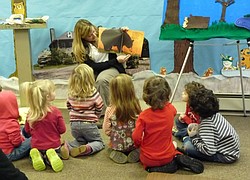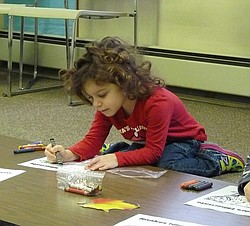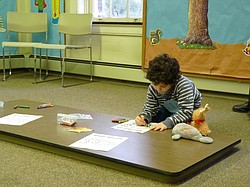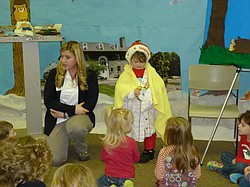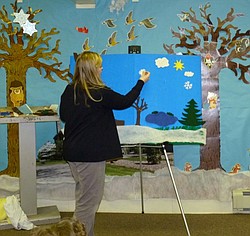Children learn about hibernation
Neighbors | Elise McKeown Skolnick.Naturalist Julie Bartolone read "Time to Sleep" by Denise Fleming at the children's nature hour Dec. 6.
Neighbors | Elise McKeown Skolnick.Ava Carbon colored a picture of a frog at the children's nature hour Dec. 6.
Neighbors | Elise McKeown Skolnick.Graham Carbon colored a picture of a bear at the children's nature hour Dec. 6.
Neighbors | Elise McKeown Skolnick.Naturalist Julie Bartolone dressed Maximus Marino up as if he were going to sleep for the winter to demonstrate hibernation.
Neighbors | Elise McKeown Skolnick.Using a felt board, naturalist Julie Bartolone demonstrated how the environment changes during winter at the children's nature hour Dec. 6.
By ELISE McKEOWN SKOLNICK
Snow has started falling in the Mahoning Valley, and that means many animals are starting to hibernate. Children aged 3-6 learned all about them at children’s nature hour Dec. 6.
The “Time to Sleep” program, offered at the Ford Nature Center in Mill Creek Park, focused on hibernating animals.
“We’ll touch upon migrators and active animals a little bit,” said Julie Bartolone, naturalist.
Participants, wearing snowflake-shaped nametags, colored pictures of hibernating animals while they waited for the program to begin. They chose from a frog, turtle, snake and bear.
Ava Carbon, of Boardman, colored a frog.
“I’m making this for Grandpa,” she said.
Her brother, Graham, chose a bear. He knew before the program started that bears hibernate.
Books about hibernating, including “When Will it Snow?” by Bruce Hiscock and “Dear Rebecca, Winter is Here” by Jean Craighead George, where on display. Bartolone read “Time to Sleep” by Denise Fleming to the children.
“Can you all say hibernation with me?” Bartolone asked the children.
And the children did.
“Very good,” Bartolone said. “That’s when animals go to sleep for the winter.”
Some animals remain active throughout the winter and others fly, walk or swim to warmer climates, she told the children. But some find winter too cold and it can be difficult to find food, so they hibernate.
They discussed several animals and the way they hibernate. For example, frogs and turtles bury themselves in the mud at the bottom of ponds, and snakes curl up under rocks or logs.
The children also sang “The Weather’s Getting Cold” to the tune of “The Wheels on the Bus” and made a craft of a bear hibernating in a cave.
 43
43

